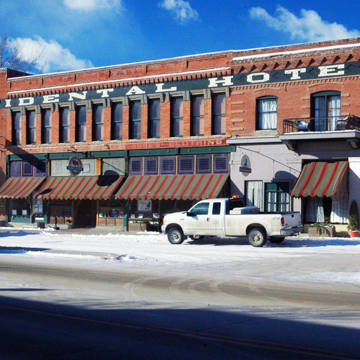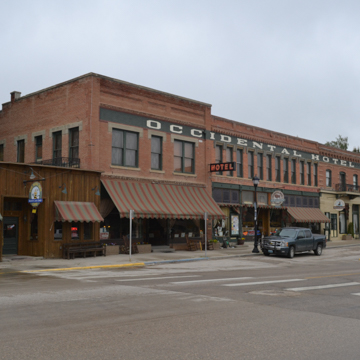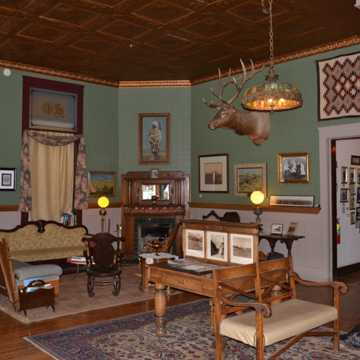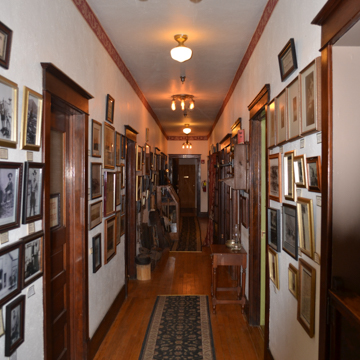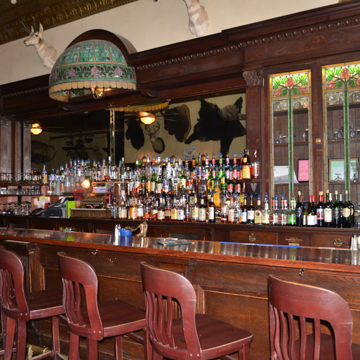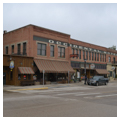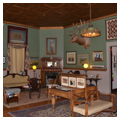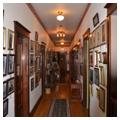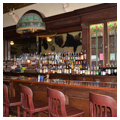Buffalo, located at the foot of the Bighorn Mountains in northeastern Wyoming, was first settled by Euro-Americans in the 1860s. In 1879, the town of Buffalo was a growing community of cattlemen and homesteaders, and was incorporated as the county seat of Johnson County. The original Occidental Hotel, built circa 1880 by Charles Buell, was a two-story log building with a gambrel roof and gabled dormers. The hotel included six guest rooms, a saloon, kitchen, and livery stable. It was an improvement over the tent where Buell had first offered shelter, food, and as local legend tells, secure storage for gold, to travelers along the Bozeman Trail, which ran through the town.
As Buffalo expanded in the early 1900s into a thriving commercial center for the surrounding ranches and dude ranches, Buell replaced the log hotel with a two-story brick building, which he added onto in 1908 and 1910. Each of the three sections of the hotel building included space for shops and restaurants on the ground floor, with rooms on the second floor.
Today, the Occidental Hotel occupies a full block on the west side of Main Street, facing east. It is unusual in that it looks more like a standard early-twentieth-century row of brick commercial buildings than a hotel. The three sections of the building, built in sequence from north to south, are easily discernible. A fourth section—a one-story café—was later built onto the south end of the building, directly overlooking Clear Creek.
The southernmost brick section is slightly taller than the other two, and has three windows in the upper story with concrete window hoods and sills and two corbelled brick friezes above. The name of the hotel is painted on a panel below the cornice that stretches across the entire facade. The south section contains the entrance to the hotel lobby, in a traditional storefront configuration. A neon sign reading “HOTEL” projects from the second story, and another neon sign reading “Occidental” is above the entrance.
The middle section is about twice as wide as the two end sections, and contains a double cast-iron storefront, with two entrances each flanked by canted plate-glass storefront windows and topped by a wide transom of small leaded-glass squares. The second story contains twelve double-hung windows, each separated by a brick pier. The northernmost section, whose first story has been covered with a concrete facing, has several asymmetrically spaced windows and doors on the first floor. The upper story of this section has quoin-like decorations at the front corners and along the sides of the middle window, which also has a wrought-iron balconette. All three upper-story windows are topped by segmental arches. The corbelling on this section is especially elaborate.
The interior of the hotel retains the look and feel of the late nineteenth century in its finishes and furnishings. The first floor contains a lobby, saloon, and restaurant, all with high, stamped-tin ceilings (painted gold), wood floors, and dark wood trim. The lobby is arranged like a parlor, with antique furniture grouped around a corner fireplace, and paintings, rugs, and mounted trophies on the walls. The reception desk is tucked under an open staircase leading to the second-floor guest rooms and suites. The lobby and an adjoining hallway exhibit the history of the Occidental through a display of photographs and artifacts.
Buell owned and operated the hotel until 1919, when he lost it in a high-stakes poker game to J.R. Smith. Smith’s daughter-in-law, Margaret, ran the hotel for 59 years. During the Depression, she ran the hotel as a boarding house, and later converted some of the rooms to apartments for retirees. Margaret Smith died in the late 1970s, and her heirs ran the hotel for a few years, without much success. It was closed from 1986 until 1997, when it was purchased, restored, and reopened by Dawn and John Wexo. Although Smith had “updated” the hotel with dropped ceilings and new wall coverings, the original finishes remained intact underneath.
Today the Occidental Hotel proudly displays its original wall coverings, woodwork, tin ceilings, Charles Rennie Macintosh–designed bar imported from Glasgow, and much of its original furniture (which had been stored in the attic). Many of these original pieces could be the same that the hotel’s famous guests once saw and used. Individuals like Butch Cassidy, Tom Horn, Calamity Jane, Buffalo Bill Cody, General Phil Sheridan, Presidents Theodore Roosevelt and Herbert Hoover, Ernest Hemingway, and Owen Wister were all reportedly guests at some time. The history of Buffalo and the Occidental Hotel are indelibly linked, continuing to change and grow together. The hotel serves the local community as well as visitors, with popular weekly bluegrass jams and other events.
References
“Occidental Story.” Occidental Hotel. Accessed April 12, 2016. http://www.occidentalwyoming.com/.














